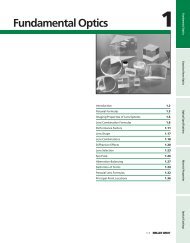Intel PXA250 and PXA210 Applications Processors
Intel PXA250 and PXA210 Applications Processors
Intel PXA250 and PXA210 Applications Processors
You also want an ePaper? Increase the reach of your titles
YUMPU automatically turns print PDFs into web optimized ePapers that Google loves.
Introduction<br />
Table 1-3. Signal Pin Descriptions (Sheet 5 of 7)<br />
Name Type Description<br />
SDA<br />
PWM Pins<br />
PWM[1:0]/<br />
GPIO[17,16]<br />
Dedicated GPIO Pins<br />
GPIO[1:0]<br />
GPIO[14:2])<br />
GPIO[22:21]<br />
Crystal Pins<br />
ICOCZ<br />
ICOCZ<br />
ICOCZ<br />
ICOCZ<br />
ICOCZ<br />
I2C Data signal (bidirectional).<br />
Bidirectional signal. When it is driving, it functions as an open collector device <strong>and</strong><br />
requires a pull up resistor. As an input, it expects st<strong>and</strong>ard CMOS levels.<br />
Pulse Width Modulation channels 0 <strong>and</strong> 1 (outputs)<br />
See Note [2]<br />
General Purpose I/O: These two pins are contained in both the <strong>PXA250</strong> <strong>and</strong> <strong>PXA210</strong><br />
applications processors. They are preconfigured at a hard reset (nRESET) as wakeup<br />
sources for both rising <strong>and</strong> falling edge detects.<br />
These GPIOs do not have alternate functions <strong>and</strong> are intended to be used as the main<br />
external sleep wakeup stimulus.<br />
General Purpose I/O<br />
See Note [1]<br />
See Note [2]<br />
General Purpose I/O<br />
Additional general purpose I/O pins.<br />
PXTAL IA Input connection for 3.6864 Mhz crystal<br />
PEXTAL OA Output connection for 3.6864 Mhz crystal<br />
TXTAL IA Input connection for 32.768 khz crystal<br />
TEXTAL OA Output connection for 32.768 khz crystal<br />
48MHz/GP[7] ICOCZ 48 MHz clock. (output) Peripheral clock output derived from the PLL.<br />
RTCCLK/GP[10] ICOCZ Real time clock. (output) HZ output derived from the 32kHz or 3.6864MHz output.<br />
3.6MHz/GP[11] ICOCZ 3.6864 MHz clock. (output) Output from 3.6864 MHz oscillator.<br />
32kHz/GP[12] ICOCZ 32 kHz clock. (output) Output from the 32 kHz oscillator.<br />
Miscellaneous Pins<br />
BOOT_SEL<br />
[2:0]<br />
PWR_EN<br />
nBATT_FAULT<br />
IC<br />
OCZ<br />
IC<br />
Boot programming select pins. These pins are sampled to indicate the type of boot<br />
device present per the following table;<br />
BOOT_SEL[2:0] Description<br />
000Asynchronous 32-bit ROM<br />
001Asynchronous 16-bit ROM<br />
100One 32-bit SMROM<br />
101One 16 bit SMROM<br />
110Two 16 bit SMROMs (32 bit bus)<br />
111Reserved<br />
Power Enable. Active high Output.<br />
PWR_EN enables the external power supply. Negating it signals the power supply<br />
that the system is going into sleep mode <strong>and</strong> that the VDD power supply should be<br />
removed.<br />
Battery Fault. Active low input.<br />
The assertion of nBATT_FAULT causes the applications processor to enter Sleep<br />
Mode.The applications processor will not recognize a wakeup event while this signal<br />
is asserted. Use nBATT_FAULT signal to flag a critical power failure, such as the main<br />
battery being removed. Minimum assertion time for nBATT_FAULT is 1ms.<br />
1-8 <strong>PXA250</strong> <strong>and</strong> <strong>PXA210</strong> <strong>Applications</strong> <strong>Processors</strong> Design Guide
















